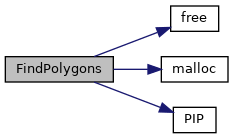◆ FindPolygons()
Definition at line 437 of file shp2pgsql-core.c.
void * malloc(YYSIZE_T)
void free(void *)
int PIP(Point P, Point *V, int n)
PIP(): crossing number test for a point in a polygon input: P = a point, V[] = vertex points of a pol...
Definition: shp2pgsql-core.c:415
Definition: shp2pgsql-core.c:26
Definition: shp2pgsql-core.c:31
References free(), struct_ring::linked, struct_ring::list, LWDEBUGF, struct_point::m, malloc(), struct_ring::n, struct_ring::next, SHPObject::nParts, SHPObject::nVertices, SHPObject::padfM, SHPObject::padfX, SHPObject::padfY, SHPObject::padfZ, SHPObject::panPartStart, PIP(), struct_point::x, struct_point::y, and struct_point::z.
Referenced by GeneratePolygonGeometry().
Here is the call graph for this function:

Here is the caller graph for this function:
